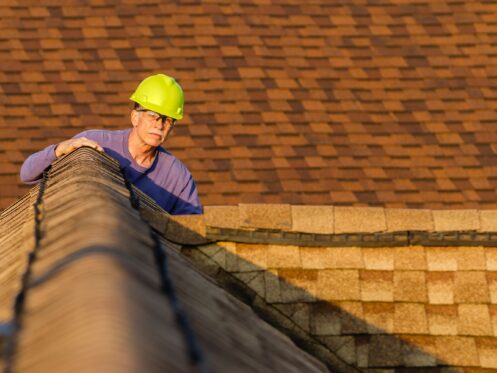Even with regular maintenance, roofing issues still happen due to storm damage, aging materials, or hidden wear and tear. When problems occur, it’s important to address them quickly, but safety should always come first.
Whether you’re planning to inspect the roof yourself or preparing for a contractor’s visit, taking the right precautions can help prevent accidents and protect your home. Below are key roof repair safety tips every homeowner should keep in mind.
You’ll notice the common thread throughout all of these is that we strongly discourage any activity that involves climbing onto your roof. While many homeowners will still do this, we need to do our part to say that incidents are common, and no one is immune to mistakes. That’s why we recommend calling an expert roofer who has safety equipment, training, and an insured roofing company behind them.
Be Mindful of Ladder Placement
We advise never climbing onto your roof. However, many homeowners choose to risk it. While we recommend leaving anything requiring a ladder to the experts, if you do decide to climb onto your roof, use extreme caution.
While many homeowners may feel comfortable using a ladder to inspect areas that are not visible from the ground, especially if you suspect a problem, it is best to leave any repairs or technical work to trained professionals.
Even inspections can pose safety risks if not done carefully. If you use a ladder to check your roof, be extremely mindful of overhead power lines. Never place a ladder within 10 feet of any power line. To reduce the risk of electrocution, choose a wood or fiberglass ladder instead of a metal one. These materials do not conduct electricity. If a metal ladder makes contact with a live wire, the risk of serious injury or death is immediate.
Always climb carefully. Use three points of contact at all times, such as two hands and one foot or two feet and one hand, to help maintain balance. Avoid standing on the top step of the ladder. Make sure the ladder extends at least three feet above the roofline to provide a stable transition point. These safety practices can help reduce the risk of falls and accidents, even if you are only climbing up for a brief look.
Be Cautious When Clearing Storm Debris
After a major storm, it’s common to find debris scattered across your roof. This might include loose shingles, broken tree limbs, or even objects from your or a neighbor’s lawn. While it’s understandable to want to clean things up quickly, it’s essential to take your time and approach roof cleanup with care.
If shingles have come loose and are resting on top of others, avoid dragging them across the surface. Doing so with a rake, broom, or similar tool can scrape away the protective granules that cover the top layer of your shingles. These granules are essential to shielding your roof from sunlight, moisture, and other elements.
Once they’re gone, the shingle begins to degrade much faster. Instead, remove loose shingles by hand whenever it’s safe to do so.
The same caution applies to downed tree branches. A heavy limb may appear stable but could shift unexpectedly while you’re on the roof. Never try to break or yank a large branch out of the way. If it’s wedged or entangled, forcing it can tear up shingles or damage the roof deck beneath. It’s better to wait and have a professional handle it, especially if there’s any chance the branch has punctured the roofing surface.
Even smaller debris, like twigs and leaves, can hide damage or create slippery footing. Take your time and wear proper footwear with a good grip. Always assess your surroundings if you decide on climbing up. However, we can’t stress enough how dangerous it is and how common accidents are, so call a professional roofing services contractor to stay truly safe.
Know Your Roofing Material
Some types of roofing are not safe to walk on, even briefly. Tile, slate, and metal roofs are common examples. These materials can be extremely slippery and may crack or break under pressure. Metal roofing, in particular, offers very little traction, making it easy to lose your footing.
Additionally, if your home has any of these roofing types, it’s best not to attempt walking on them at all. Even a quick step onto the surface to check for damage can result in cracked tiles or dents, which only add to your repair costs. Trained professionals know how to navigate these materials without causing additional damage; leave the inspection and repairs to them.
Never Get on a Wet Roof
Even a modest roof pitch can be tricky to walk on, and wet conditions make it far more dangerous. Water reduces traction, making it much easier to slip even on asphalt shingles. A fall from the roof, even from a single story, can cause serious injuries.
Keep Pets and Children Away
Whether you’re climbing a ladder to inspect your roof or a professional crew is on-site making repairs, it’s important to establish a safe work zone. Children and pets should be kept well away from the area surrounding your home. Falling tools, loose shingles, or other debris can pose serious safety risks.
Before any roofing work begins, take a few minutes to assess the space around your home. Move outdoor furniture, grills, vehicles, and any other belongings that falling materials could damage. If possible, use cones, caution tape, or temporary fencing to clearly mark the work zone. This not only helps protect your family and property but also ensures that guests or neighbors passing by stay at a safe distance.
Be Mindful of Indoor Hazards
Roofing work often causes vibrations throughout the home, especially during the removal of old materials or when new shingles are nailed into place. These vibrations can sometimes cause items to shift or fall indoors, particularly those hanging on walls or on high shelves.
Before repairs begin, take a few minutes to walk through your home and secure or temporarily remove fragile items, such as picture frames, mirrors, decorative objects, or anything perched near the edge of a shelf. Even a small shift can cause these items to fall, potentially damaging your belongings.
Identify Usable Outdoor Outlets
Roof repairs often require power tools, and unless your roofer uses battery-powered equipment, they’ll need access to electricity. Before any work begins, take a moment to check that your outdoor outlets are working. Ideally, there should be at least one functioning outlet on each side of your house to give them flexibility in setting up tools and extension cords.
Avoid running cords through windows or doors. This creates a tripping hazard, lets bugs in, and allows air to escape, forcing your HVAC system to work harder.
A Note on Warranty Repairs
Most roofing materials come with a manufacturer’s warranty that covers defects or early product failures. However, following the terms outlined in the warranty is important to keep that coverage valid. In many cases, the manufacturer requires that any inspection or repair work be performed by a licensed professional.
If you attempt to repair the roof yourself, you could unintentionally void the warranty. This means you’d be responsible for the full cost of any future repairs, even if the materials were faulty. Before making any decisions, check the warranty documentation or contact the manufacturer to understand what’s required to keep your coverage intact.
Expert Roof Repair Service
Fraser Roofing, LLC provides expert roof repair services to the Atlanta, GA community. We can also assist with all your roofing installation, replacement, and maintenance needs. Contact us today to schedule an appointment with one of our experienced roofers.

